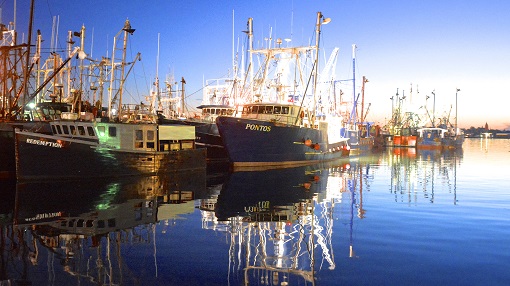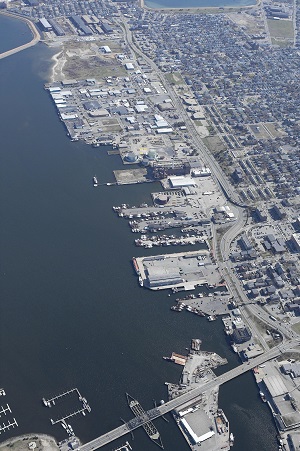
The Port of New Bedford, America’s most valuable commercial fishing port, has released a six-pronged plan for the revitalization of the Northeast’s struggling groundfish fishery, and to expand the port’s overall functionality. According to the New Bedford Harbor Development Commission’s (HDC) “Groundfish Port Recovery and Revitalization Plan for the Port of New Bedford and Fairhaven,” the region’s groundfish fishery stands to improve if fisheries scientists and managers apply similar video survey technology as that which helped revive the region’s now-successful scallop fishery. Along with soliciting grant funds to develop video surveys for groundfish, as the nation’s number one fishing port, the city has released its recommendations for modifications to the Magnuson-Stevens Act (MSA), the Federal law governing all domestic fisheries management.
The Revitalization Plan presents a counterpoint to NOAA’s recently released “Fisheries Economics of the U.S. 2012” report. While touting the “strong economic gains from fishing” and “continued improvement in fish stocks” in the nation’s fisheries, the report gives scant attention to New England’s once-thriving groundfish fleet. The HDC’s plan, coupled with help from local leaders and academics, signifies a collaborative and proactive effort to reinvigorate the northeast groundfish fishery and solidify the port’s sustainable future.
“In the nineteenth century, New Bedford became the center of American whaling and today it remains one of the most important ports in the world,” said New Bedford Mayor Jon Mitchell. “New Bedford is the nation’s number one fishing port, and we intend to keep it that way for the next hundred years. We’re the best, and we’re going to stay the best. To do that, we need the best science in stock surveys and assessments-that is critical for both scallops and groundfish,” the mayor continued.
“I applaud the work of Dan Georgianna and his colleagues at the School for Marine Science and Technology at the University of Massachusetts, Dartmouth in compiling this report. We must do all we can to maintain New Bedford’s economic contribution as the highest value catch port in the U.S.” said State Senator Mark Montigny (D-New Bedford) who over the years has secured funding for port revitalization and fishing research, including funding for this Plan.
Technology That Can Truly Count the Fish (and Without Harm)

In its number one recommendation, the Plan emphasizes the need for accurate stock assessments, which are critical in ensuring that species are sustainably managed and that catch levels are set appropriately. The Plan calls for the expanded use of video survey technology in groundfish assessments to more accurately measure the abundance of key groundfish stocks, like yellowtail flounder. This video survey technology, recently demonstrated by Dr. Kevin Stokesbury of the University of Massachusetts School for Marine Science and Technology (SMAST), draws from the same techniques that revolutionized scallop surveys over a decade ago.
Current survey vessels and methods are limited in their ability to sample species like yellowtail flounder. To avoid catching too many yellowtail, whose population is presently estimated by conventional techniques to be low, surveys are conducted with a relatively small number of tows, over a relatively small section of the species’ habitat range. SMAST’s proposed video survey method addresses this shortcoming by towing with an open net, allowing fish to pass through unharmed. Rather than counting the number of caught yellowtail on deck or at the dock, the SMAST video survey counts them using cameras placed at the tail of the net. SIMRAD, a manufacturer of fish monitoring and fish finding equipment, provided SMAST with some of its newest and most advanced equipment for the survey, specifically its FX80 camera system and PI50 sensor system
Dr. Stokesbury worked with fishermen, who have often been critical of the nets used in current government surveys, as well as the manner in which survey vessels have deployed them, to develop gear that fishermen agreed would be most effective at catching yellowtail flounder. The purpose-built net, combined with this non-lethal video survey method, allows for longer survey tows over a larger area, producing a more accurate count of the surveyed species.
“We start by using the fishermen’s knowledge and then apply the very best and latest technology on top of that,” said Dr. Kevin Stokesbury.
On April 29, Massachusetts state Representative Antonio Cabral (D-New Bedford) successfully inserted $450,000 in funding for the survey into the draft of the state’s budget. The Massachusetts House ultimately approved that version of the budget on April 30.
“Our fishing industry depends on accurate science, and Massachusetts is stepping up to fund that research,” said Rep. Cabral. “If we can demonstrate a large return on this $450,000 investment, I hope we can spur the federal government to invest in the level of fisheries research that’s really needed.”
The city of New Bedford and the HDC are also working to apply a $75,000 grant to the survey, which, along with the money provided in the state budget, would fully fund the survey’s estimated $500,000 cost.
“We are seeking grant money now to bring proven technology that has revitalized the scallop industry to the groundfish industry. We will work with NOAA to develop better science, but we are not going to wait for NOAA to develop better science,” said Mayor Mitchell.
Fixing Federal Law
The Plan also prioritizes needed reforms to the Magnuson-Stevens Act. The MSA is currently undergoing Congressional reauthorization, and during this time the Plan recommends clarifications to the Act’s National Standards, which are seen by many as ambiguous. Among the Plan’s specific recommendations are reducing the total number of National Standards from ten to five; maximizing yield within the constraints set by regulations; setting conservation goals based on the best available scientific information and derived from collaborative research between the government, fishermen, and marine scientists; minimizing bycatch; considering fisheries’ respectively unique distinctions when setting management goals; minimizing costs; and considering efficiency when allocating resources, including non-economic considerations.
“Groundfish have supported generations of Massachusetts families. This study outlines what can be done – right now – to revitalize the fishery. Poorly-implemented federal regulations have failed to protect our ecosystems but succeeded in crippling our fishing fleet,” said State Senator Montigny.
The Plan also calls for changes in the way fisheries are managed, including clearly defining NOAA’s role in fisheries management, establishing ways to measure the performance of fisheries management plans, relaxing the strict 10-year stock rebuilding requirements currently required under the law, increased cooperative research efforts, and establishing new scientific working groups to improve the review process.
Resources:
- Read/Download the Full Groundfish Port Recovery and Revitalization Plan for the Port of New Bedford/Fairhaven
- Watch footage from the recent demonstration of video survey technology.
- View Additional Recommendations and Economic Data from the New Bedford Harbor Development Commission
- View the Preliminary Results of Dr. Kevin Stokesbury’s Video Survey of Georges Bank Yellowtail Flounder in Closed Area II
 New Bedford Guide Your Guide to New Bedford and South Coast, MA
New Bedford Guide Your Guide to New Bedford and South Coast, MA







